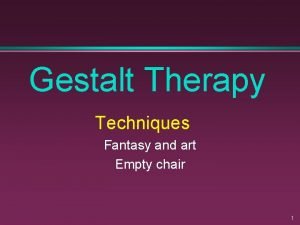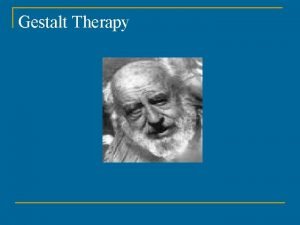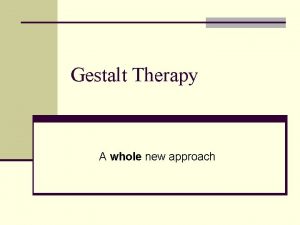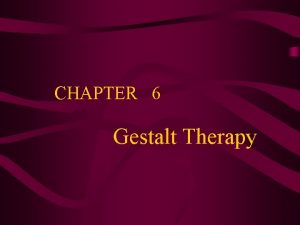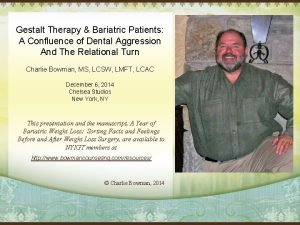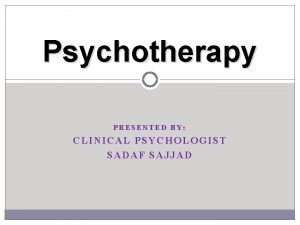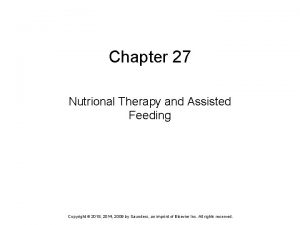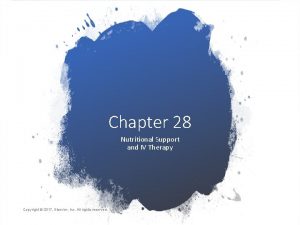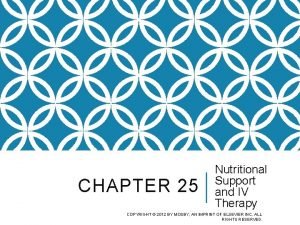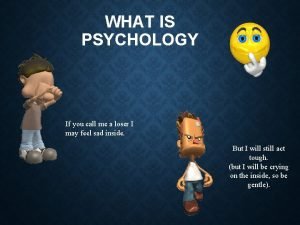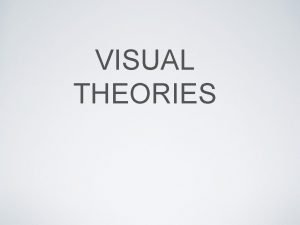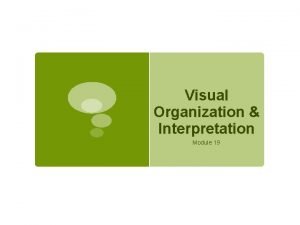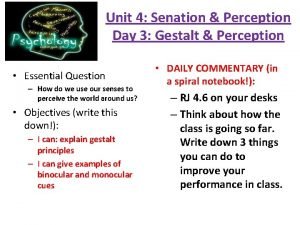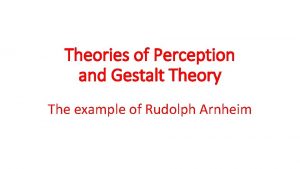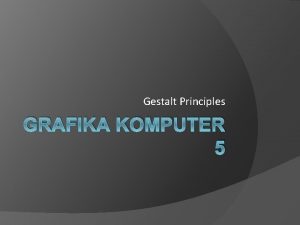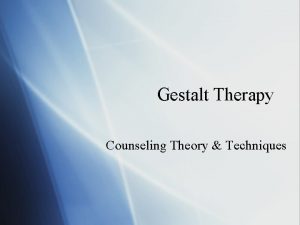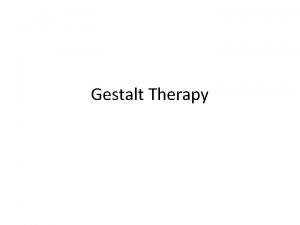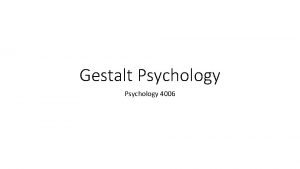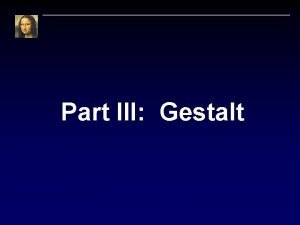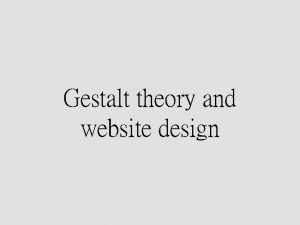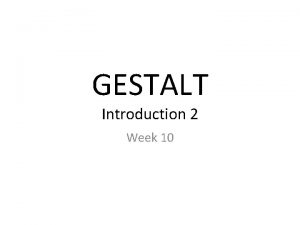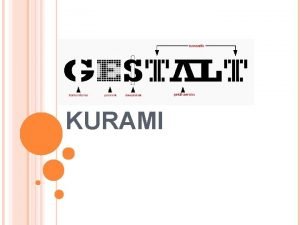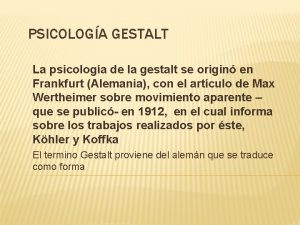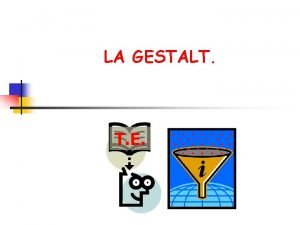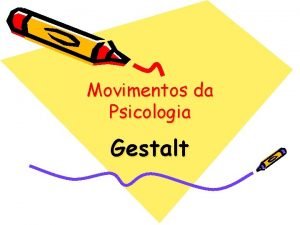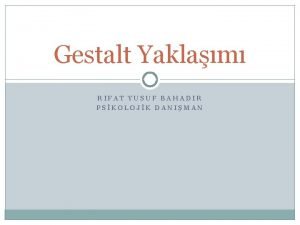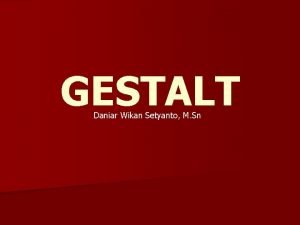Chapter 8 Gestalt Therapy What is Gestalt Therapy





















- Slides: 21

Chapter 8 Gestalt Therapy

What is Gestalt Therapy? �The initial goal is for clients to gain awareness of what they are experiencing and how they are doing it. �Through this awareness, change automatically occurs. �The approach is phenomenological because: �Focuses on client’s perceptions of reality �The approach is existential because: �Grounded in the notion that people are always in the process of becoming; remaking & rediscovering themselves

Key Concepts Gestalt Therapy puts emphasis on the client’s relationship with his/her own environment Individuals have the capacity to self-regulate when they are aware of what is happening in and around them �The environment consists of both the external and internal worlds: �External: Outside factors, such as other people �Internal: Parts of the self, such as those that have been disowned

Key Concepts The paradoxical theory of change states that we change when we are aware of what we are, we opposed to trying to become what we are not. It is important for clients to “be” as fully as possible, rather than striving to become what they “should be” Gestalt therapists focus on creating the conditions that promote client growth rather than using therapistdirected change

Gestalt Therapy Principles Holism �German word meaning “whole” or “completion” �Gestalt therapists are interested in the whole person, and put no superior value on a particular aspect of an individual �Attends to a client’s thoughts, feelings, behaviors, body, memories, and dreams �Gestalt therapist pays attention to how the parts fit together, how the individual makes contact with the environment, and integration

Gestalt Therapy Principles Field Theory �The principle that a person must be seen in its environment, or in its context, as part of the constantly changing field �Everything is interrelated and in process �The field is the entire situation of therapist, the client, and all that goes on between them. The field is made and constantly remade.

Gestalt Therapy Principles The Figure-Formation Process �Describes how the individual organizes experience from moment to moment. �The field differentiates into a foreground (figure) and a background (ground) � Figure: Those aspects on an individuals experience that are most salient at a given moment � Ground: Those aspects of the client’s presentation that are often out of his/her awareness. �The figure-formation process tracks how some aspects of the environmental field emerges from the background into the individual’s attention and interest

Gestalt Therapy Principles Organismic Self-Regulation �Process in which equilibrium is “disturbed” by the emergence of a need, sensation, or interest. �Organisms will do their best to regulate themselves, given their own capacities and environmental resources �Intertwined with the figure-formation process

Focus on the Now �Emphasis on learning to appreciate and fully experience the present moment �Focusing on the past and future can be a way to avoid coming to terms with the present �Gestalt therapists ask “what” and “how” questions, but rarely ask “why” questions. �The therapist encourages dialogue in the present by asking present-tense questions

Focus on the Now Gestalt therapists recognize the past will make regular experiences in the present moment. �Usually because of some unfinished business with that past experience When clients speak of the past, therapist may reenact it as though they were living it now Empty chair technique- The client speaks to an empty chair in session as if the person they are thinking of is actually sitting there

Contact and Resistances to Contact Effective contact means interacting with the environment without losing a sense of individuality Resistances to contact(pg 205): �Introjection �Projection �Retroflection �Deflection �Confluence

Methodology There are 6 components considered vital or integral to Gestalt therapy: �The continuum of experience �The here and now �The paradoxical theory of change �The experiment �The authentic encounter �Process-oriented diagnosis

Importance of Language Some aspects of language therapists might focus on: �“It” talk – Depersonalizing language �“You” talk – Hiding the self �Questions – Avoiding statements �Language the denies power – Maybe, sort of �Listening to clients’ metaphors – “After this session, I feel like I’ve been put through a meat grinder” �Listening to language that uncovers a story

Client’s Experience Gestalt therapists do not make interpretations as to why a client is acting in a certain way. �The therapist is not the expert on the client’s experience Clients in Gestalt therapy are active participants who make their own interpretations and meanings �It is they who increase awareness and decide what they will or will not do with their personal meaning

Stages of client growth �Discovery – Clients are likely to reach a new realization about themselves or gain a new view on an old situation �Accommodation – Clients recognize that they have a choice. They begin by trying new behaviors in therapy, then expand their awareness of the world �Assimilation – Clients learn how to influence their environment. They have learned what they can do to maximize their chances of getting what is needed from their environment

Students will be allowed to drop the lowest exam grade of the semester and replace this grade with the equivalent of the highest grade such that the highest grade earned on any of the three exams will be counted twice. The second highest grade will also be used to calculate the students’ final grade in the course. At the end of the semester, the student’s 3 exam grades will consist of: �Their highest exam grade x 2 �Their middle exam grade �Their lowest exam grade will be dropped

Note: Students will be responsible for verifying the score earned on the Exam 1 or this exam will be the one dropped from the final course grade. Students are required to return their scantron to the instructor by the end of the semester if they wish to keep their Exam 1 grade and drop another exam grade. If a graded scantron is not returned by 5/5, then the instructor will drop the Exam 1 grade and replace it with the highest remaining exam grades in the calculation of the final grade for the course.

Exercises and Experiments �Exercises are ready-made techniques that are used to make something happen in a therapy session or to achieve a goal. �Experiments emerge within the dialogic process and grow out of the interaction between client and therapist. �Occur on a moment-to-moment basis, and are tailored to the individual. A therapist may recognize a unique opportunity for the client to gain fresh emotional experiencing and new insight.

Experiments cont. Experiments are meant to expand a client’s awareness and to help them try new modes of behavior �Experiments require the client’s active role in selfexploration �If the client is hesitant, it is a good idea to explore its meaning for the client �The counselor should be ready to scale down tasks so that the client has a good chance to succeed.

Exercise Examples �The Reversal Exercise – Asking a client to act oppositely than they usually do �Staying with the Feeling – Embracing the fearful stimuli being experienced

Example Question Gestalt therapy is a form of: a) b) c) d) Freudian psychoanalytic therapy Neo-Freudian psychoanalytic therapy Behavior therapy Existential therapy
 Peeling the onion psychology
Peeling the onion psychology Gestalt therapy empty chair
Gestalt therapy empty chair Reality therapy examples
Reality therapy examples Ububer
Ububer A whole new approach
A whole new approach Layers of neurosis gestalt
Layers of neurosis gestalt Confluence gestalt
Confluence gestalt Sadaf sajjad
Sadaf sajjad Gestalt therapy goals
Gestalt therapy goals Psychodynamic and humanistic therapies have in common
Psychodynamic and humanistic therapies have in common Bioness bits cost
Bioness bits cost Humanistic therapies aim to boost
Humanistic therapies aim to boost Chapter 27 nutritional therapy and assisted feeding
Chapter 27 nutritional therapy and assisted feeding Chapter 19 methods of therapy
Chapter 19 methods of therapy Chapter 28 nutritional support and iv therapy
Chapter 28 nutritional support and iv therapy Chapter 28 nutritional support and iv therapy
Chapter 28 nutritional support and iv therapy Chapter 28 nutritional support and iv therapy
Chapter 28 nutritional support and iv therapy Wolfgang kohler ap psychology
Wolfgang kohler ap psychology Gestalt and constructivism
Gestalt and constructivism Gestalt psychology illusions
Gestalt psychology illusions Convergence gestalt
Convergence gestalt Gestalt theory of perception examples
Gestalt theory of perception examples

